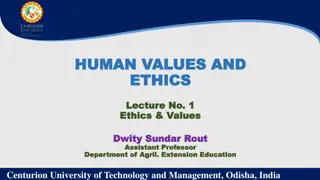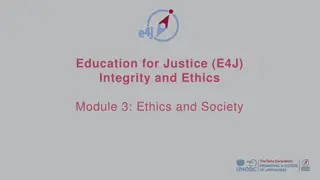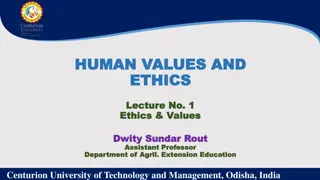Responsible Research & Ethics in Life Sciences Module 4
This virtual course on responsible research, export control, and ethics in the life sciences, focusing on chemical, biological, radiological, and nuclear sciences, emphasizes the importance of intangible technology, tacit knowledge, and the international legal regime in shaping scientific practices within societal contexts.
Download Presentation

Please find below an Image/Link to download the presentation.
The content on the website is provided AS IS for your information and personal use only. It may not be sold, licensed, or shared on other websites without obtaining consent from the author.If you encounter any issues during the download, it is possible that the publisher has removed the file from their server.
You are allowed to download the files provided on this website for personal or commercial use, subject to the condition that they are used lawfully. All files are the property of their respective owners.
The content on the website is provided AS IS for your information and personal use only. It may not be sold, licensed, or shared on other websites without obtaining consent from the author.
E N D
Presentation Transcript
Ethics and responsible research Module 4 A virtual course on responsible research, export control and ethics in the life sciences related to chemical, biological, radiological and nuclear sciences Concept and content by Ineke Malsch with contributions from Dr Maria Espona and Kamshat Saginbekova
Acknowledgements This virtual course on responsible research, export control and ethics in the life sciences related to chemical, biological, radiological and nuclear sciences has been produced and prepared for the International Science and Technology Center (ISTC) as part of the EU funded Targeted Initiative on CBRN Export Control on Dual-Use Materials and Intangible Technologies. The support of the European Commission for this course does not constitute endorsement of the contents which reflects the views only of the authors. The content of the course was created by Ineke Malsch. The project team of the Targeted Initiative on CBRN Export Control on Dual-Use Materials and Intangible Technologies provided comments and editing of the material. This module benefitted from additional material from Dr Maria Espona and Ms Kamshat Saginbekova
Module 3 Raising context awareness Introduction context awareness Science is not performed in a vacuum it is embedded in society and subject to judgement, choices, and to conflict of interests and values. has a transformative impact on society inherently directed by society. The role of intangible technology (knowledge) and tacit knowledge are addressed in every export control legislation and framework. This means that scientists and other knowledge workers must be aware of these rules. The international legal regime includes regulations fostering academic freedom as well as protecting biosafety and security of citizens and society. The export control regime is a key element of the context which influences the freedom of scientists to publish their results, to collaborate with international partners, and obtain materials.
Module 3 Raising context awareness The role of intangible technology (e.g. knowledge) and tacit knowledge Any scientific or technological process incorporates two types of knowledge: explicit and tacit. Explicit knowledge Tacit knowledge is information that can be codified and written down, such as a recipe or a laboratory protocol involves subtle hands on skills that cannot be reduced to writing but must be acquired through a lengthy process of apprenticeship Knowledge is an important part of technology and thus an important element for control Many export control regimes have clauses for intangible technology transfers (ITT). ITT is ostensibly about controlling the knowledge component of technology and is an essential and integral part of an export control regime.
Module 3 Raising context awareness The role of intangible technology (e.g. knowledge) and tacit knowledge Distinctions in tacit knowledge (Vogel, 2006) personal tacit knowledge refers to laboratory skills that are acquired either by person-to-person transfer ( learning by example ) or trial-and-error problem- solving ( learning by doing ) communal tacit knowledge resides in teams of scientists that are made up of specialists from different disciplines. Many technologies require both personal and communaltacitknowledge. This might also limit ability of (non-)state actors to exploit them for harmful purposes and busts the myth of blueprints on the internet for complex designs. There is considerable debate about tacit knowledge requirements being eroded by technological advances, such as automation processes This differentiated conceptualisation allows identification of points to interdict and identify barriersto acquisition and or proliferation.
Module 3 Raising context awareness International legal regime related to dual use aspects There is a complex framework of laws, norms, regulations, codes, customs, treaties, and conventions to counter the spread, development production, transfer, and use of weapons and their delivery systems collectively described as the Web of Prevention the multiple overlapping measures to ensure that all potential stages or aspects of research, development and production are protected from misuse. Here, we focus on a simple overview of the relevant aspects of the international framework there are excellent resources online to follow up on for those who want to explore more. This web of prevention extends from individual responsibility to national legal instruments, regional agreements, to the normative framework provided by international conventions and treaties. Scientists need to be aware of the regime as it directly affects their work in many cases. It is in their interest to facilitate compliance but also to engage and interact: Scientists are enablers and constrainers of emerging science and technology Scientists can shape policy in this area by contributing relevant expertise because they understand the relevant science and technology and the specific context.
Module 3 Raising context awareness International legal regime related to dual use aspects The international legal regime is grouped within a number of categories, these categories are a result of their negotiation on the international level and what was seen as feasible and achievable and subject to political, diplomatic, and historical drivers. Two categorisations that are used in texts and discussions are worth mentioning and dissecting as they frequently obfuscate and often unnecessarily complicate matters: CBRN Chemical, Biological, Radiological and Nuclear Vastly different systems knowledge materials applications Legal frameworks / politics differ Institutional responsibilities considerably in Stakeholder communities WMD Weapons of Mass Destruction Historical category with no clear definition, often taken to include chemical, biological and nuclear weapon systems. However, it focusses on large-scale impacts whilst neglecting other damage categories that are also available. Nonetheless, they are widely used it is important to bear in mind the terms limitations
Module 3 Raising context awareness International Conventions related to dual use aspects of sciences We will focus on principal instruments that represent the international framework of arms control, non-proliferation and disarmament of weapons of mass destruction or chemical, biological, radiological and nuclear weapons (CBRN) The following slides will briefly outline the main treaties (international treaties and conventions) and regimes (organisations and instruments). The list is not comprehensive but should give an overview. Treaties Regimes International Organisations Biological Weapons Chemical Weapons Non-Proliferation & Export Control Nuclear Weapons Conventional Weapons & Space Arms Scientific and Technical cooperation
Module 3 Raising context awareness International Conventions related to dual use aspects of sciences Biological Weapons Convention on the Prohibition of the Development, Production and Stockpiling of Bacteriological (Biological) and Toxin Weapons (BWC) prohibits the development, production, stockpiling, or acquisition of biological and toxin weapons, and mandates the elimination of existing weapons, weapons production material, and delivery means. Prohibition of use is implicit as a common understanding among states parties. General Purpose Criterion : scope defined by purposes the materials, substances and technologies are put to rather than prohibiting them both BWC and CWC address dual- use goods in a unique way allowing peaceful uses, prohibiting hostile ones. Protocol for the Prohibition of the Use of Asphyxiating, Poisonous or Other Gases, and of Bacteriological Methods of Warfare Geneva Protocol 1925 (entry into force 1928) international agreement whose states parties have agreed among themselves not to use CBW weapons against one another (no first use agreement). Considered customary international law. It prohibits the use in war of asphyxiating, poisonous, or other gases, and of bacteriological methods of warfare. Provided the basis for the BTWC and CWC.
Module 3 Raising context awareness International Conventions related to dual use aspects of sciences Chemical Weapons Convention on the Prohibition of the Development, Production, Stockpiling and Use of Chemical Weapons and on Their Destruction (CWC) requires State Parties not to develop, produce, acquire, stockpile or retain, transfer, use, or make military preparations to use chemical weapons. It entered into force in 1997. General Purpose Criterion : scope defined by purposes the materials, substances and technologies are put to rather than prohibiting them both BWC and CWC address dual- use goods in a unique way allowing peaceful uses, prohibiting hostile ones. exemption for domestic law enforcement with riot control agents Convention on the Prohibition of Military or Any Other Hostile Use of Environmental Modification Techniques (EnMod) includes provisions to prohibit warfare with antiplant chemicals having widespread, long- lasting or severe effects .
Module 3 Raising context awareness International Conventions related to dual use aspects of sciences Nuclear Weapons Treaty on the Non-Proliferation of Nuclear Weapons (NPT) treaty aimed at limiting the spread of nuclear weapons through the three pillars of non- proliferation, disarmament, and peaceful use of nuclear energy. It differentiates between states that, at the time of signing, has nuclear weapons and those that did not, and imposes different provisions on them accordingly. Comprehensive Nuclear-Test-Ban Treaty (CTBT) prohibits nuclear weapon test explosions. It has not yet entered into force, since three of the 44 required states have yet to sign it and five to ratify it. Treaty on the Prohibition of Nuclear Weapons (TPNW) bans the use, possession, development, testing, deployment and transfer of nuclear weapons under international law. It has not yet entered into force until at least 50 countries signed and ratified. [Proposed] Fissile Material (Cut-off) Treaty (FMCT) includes provisions to prohibit warfare with antiplant chemicals having widespread, long-lasting or severe effects .
Module 3 Raising context awareness International Conventions related to dual use aspects of sciences Conventional Arms and Space Weapons Arms Trade Treaty (ATT) obligates Parties to regulate ammunition or munitions fired, launched, or delivered by enumerated conventional arms, including battle tanks, combat vehicles, missiles, missile launchers, and small arms. Parties must also regulate export of parts and components that may assemble these conventional arms. Treaty on Principles Governing the Activities of States in the Exploration and Use of Outer Space, Including the Moon and Other Celestial Bodies (Outer Space Treaty) obligates Parties not to place any objects carrying nuclear weapons in orbit, on the Moon, or on other celestial bodies. Agreement Governing the Activities of States on the Moon and Other Celestial Bodies (Moon Agreement) a supplement to the Outer Space Treaty, confirms the de-militarization of the Moon and other celestial bodies.
Module 3 Raising context awareness International Regimes related to dual use aspects of sciences International Organisations Organization for the Prohibition of Chemical Weapons (OPCW) the implementing body of the CWC; its mandate is to ensure implementation including verification measures, such as inspections of industry and other facilities, and provides a forum for consultation and cooperation among States Parties. International Atomic Energy Agency (IAEA) international center for nuclear cooperation and promotes safe, secure and peaceful nuclear technologies through cooperation with its Member States. Tasks include inspections and the safeguards regime. Preparatory Commission for the Comprehensive Nuclear-Test-Ban Treaty Organization (CTBTO Preparatory Commission) main task is establishing and provisionally operating the 337-facility International Monitoring System (IMS) for seismic detection of explosions; and its International Data Centre (IDC) and Global Communications Infrastructure (GCI). NB: the BWC has no verification mechanism and no organization yet. The Implementation Support Unit (ISU) provides technical support including conferences, outreach and maintains databases.
Module 3 Raising context awareness International Regimes related to dual use aspects of sciences Non-proliferation and Export control regimes Missile Technology Control Regime (MTCR) informal, non-treaty association of governments sharing common interests in the nonproliferation of missiles, unmanned air vehicles, and related technologies. Hague Code of Conduct Against Ballistic Missile Proliferation (HCOC) supplements the MTCR. Politically binding to curb proliferation of WMD-capable ballistic missiles. Australia Group (AG) informal association of member states that aims to coordinate national export control laws to minimize the risk of proliferation of chemical and biological weapons. Maintains periodically updated lists of controlled goods. Wassenaar Arrangement arrangement of participating states to promote transparency of national export control regimes on conventional arms and dual-use goods and technologies. Maintains periodically updated lists of controlled goods.
Module 3 Raising context awareness International Regimes related to dual use aspects of sciences Non-proliferation and Export control regimes Nuclear Suppliers Group (NSG) voluntary association of nuclear supplier countries that works to prevent nuclear proliferation by implementing guidelines for nuclear and nuclear-related exports. Zangger Committee (ZAC) consists of 38 states and establishes guidelines for implementing export control provisions and established a Trigger List of items that are subject to IAEA safeguard inspections. Global Partnership Against the Spread of Weapons and Materials of Mass Destruction formal multilateral nonproliferation initiative created by the G-8 countries in 2002. G-8 countries fund and implement projects to prevent proliferators from acquiring WMDs. Proliferation Security Initiative (PSI) informal and voluntary partnership of states, without an organizational framework, treaty or permanent staff, which facilitates cooperation to stop the transport of WMD, missiles, and related technologies.
Module 3 Raising context awareness International Regimes related to dual use aspects of sciences Non-proliferation and Export control regimes European Union (EU)* aims to promote economic and social progress in Europe; to introduce European citizenship; and to develop an area of freedom, security, and justice, among other objectives. Integrates all regimes mentioned into EU control list (EU Reg n. 428/2009 on dual use items) International Science and Technology Center (ISTC) intergovernmental organization that serves as a clearinghouse for projects that engage weapons scientists, technicians, and engineers from the CIS in civilian science and technology activities. Science and Technology Center in Ukraine (STCU) established in 1993 to support peaceful research and development activities by Ukrainian, Georgian, Uzbek, and Azerbaijani scientists and engineers formerly involved in the development of WMD. * There are a number of other regional organisations active, e.g. OSCE , NATO, CIS, EAPC, ACRS, ASEAN, KEDO, SAARC, OPANAL, ABACC, CELAC, OAS, African Union, Rio Group
Module 3 Raising context awareness International Regimes related to dual use aspects of sciences Strategic Trade Controls & Non-Proliferation United Nations Security Council Resolution 1540 (2004) requires all states to implement measures aimed at preventing non-state actors from acquiring nuclear, biological or chemical weapons, related materials, and their means of delivery. Includes wide range of measures: export and border controls, nuclear security and physical protection, and prevention of terrorism financing. has become an important instrument consolidating various aspects, acting as an umbrella for further action. UN Security Council Resolution 1540 (2004), adopted to prevent the illicit trafficking and use of WMD and their means of delivery, and related items, focuses on the need to develop and maintain appropriate and effective border, export, transit and transshipment controls. Despite a concerted effort on the part of the non-proliferation community to combat this trade, it remains a formidable challenge for customs and licensing officials to overcome. - KCL Project Alpha
Module 3 Raising context awareness Conclusion - Recap The role of knowledge International regulations not only restrict export of dual use materials and tangible technologies, but also of explicit and tacit knowledge needed for dual use materials and technologies. Some of the assumptions underlying export control of knowledge are difficult to implement and can be problematic. International legal regime: International treaties impose obligations on States Parties to support as well as regulate potentially harmful aspects of scientific research in their country. Export control regimes International export control regimes can lead to the imposition of certain restrictions on scientific research and on international research collaborations and trade in dual use technologies.
Module 3 Raising context awareness Self-assessment quiz 1. The international legal regime governing dual use aspects of life sciences a. Is directly regulating the research in life science laboratories b. Obliges all governments to regulate research c. Is only relevant to government officials d. Binds states parties to each treaty to regulate or support research in their territory 2. Export control regimes a. Are only relevant to tangible technologies and materials b. Prohibit international publications of dual use research results c. Require obtaining export permits for some listed materials, technologies and knowledge to some countries or end users d. Are designed to obstruct international scientific collaboration 3. Tacit knowledge a. Is not formalised and therefore not relevant in dual use export controls b. Must be learned through hands-on experience, and currently influences the potential for misuse of life sciences c. Is permanently needed for using dual use technologies and therefore limits the potential for misuse of these technologies
Module 3 Raising context awareness Answers to self-assessment quiz 1-d: Most international treaties require the States Parties which have signed up to them to incorporate the obligations or prohibitions included in the treaties in their national legislation. Researchers are obliged to comply with the legislation. 2-c: Export control regimes are agreements between the states which have signed up to them to control international trade in strategic dual use goods, materials, technologies including knowledge, to limit the risk of misuse. 3-b&c: The relationship between tacit knowledge and the misuse potential of dual use life sciences is complex.























